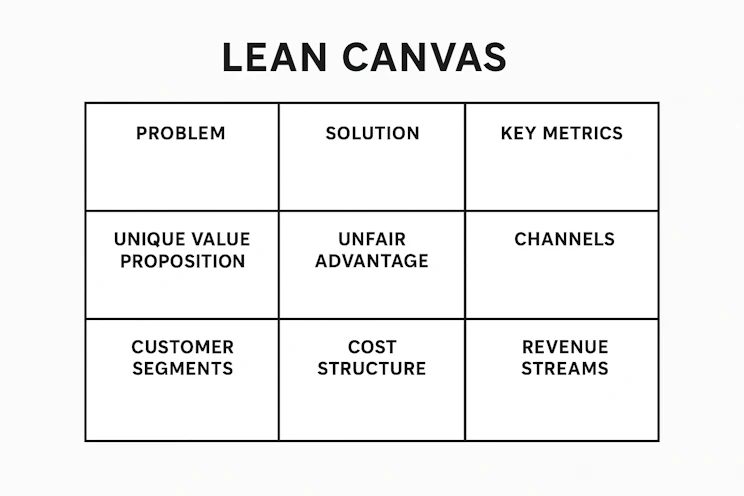Lean Canvas

What is Lean Canvas?
Lean Canvas is a one-page business model template that examines nine key elements: Problem, Solution, Key Metrics, Unique Value Proposition, Unfair Advantage, Channels, Customer Segments, Cost Structure, and Revenue Streams.
It is ideal for startups and entrepreneurs to quickly validate business ideas and is particularly effective when developing new products or services with limited resources.
How to perform a Lean Canvas
Lean Canvas – Step 1: Identify the Nine Elements
Problem | The top 1-3 problems your target customers face that your product will solve. Examples: Time-consuming manual processes, lack of affordable solutions, poor user experience with existing products. |
|---|---|
Solution | Your proposed solution to address the identified problems. Examples: Automated software platform, cost-effective alternative service, intuitive mobile application. |
Key Metrics | The key numbers that tell you how your business is performing. Examples: Customer acquisition cost, monthly active users, conversion rates, customer lifetime value. |
Unique Value Proposition | A clear statement that explains why customers should choose your product over alternatives. Examples: "10x faster than existing solutions," "First AI-powered tool for small businesses," "Complete solution in one platform." |
Unfair Advantage | Something that cannot be easily copied or bought by competitors. Examples: Patent protection, exclusive partnerships, team expertise, network effects, brand recognition. |
Channels | How you will reach your customers and deliver your product. Examples: Direct sales, online marketing, retail partnerships, referral programs, social media. |
Customer Segments | Your target customers broken down into specific groups. Examples: Small business owners, tech-savvy millennials, enterprise clients, freelance professionals. |
Cost Structure | The main costs required to operate your business. Examples: Development costs, marketing expenses, operational overhead, customer support. |
Revenue Streams | How your business will make money. Examples: Subscription fees, one-time purchases, transaction fees, advertising revenue, licensing. |
Lean Canvas – Step 2: Validate and Iterate
Use the completed canvas to test assumptions and validate your business model through customer interviews, market research, and minimum viable product (MVP) development.
Problem-Solution Fit
Verify that your solution effectively addresses real customer problems through direct customer feedback.
Product-Market Fit
Ensure there is sufficient market demand for your solution by testing with early adopters.
Business Model Validation
Confirm that your revenue streams, cost structure, and key metrics create a sustainable business model.
Finally, continuously update your Lean Canvas based on learnings and pivot when necessary to achieve product-market fit and business success.